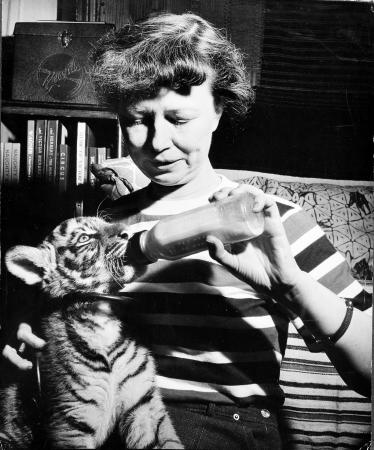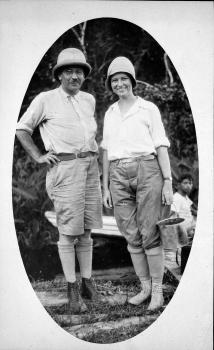We’re thinking about the “meet-cute” here at the Archives as Valentine’s Day approaches. Merriam-Webster defines the meet-cute as “a cute, charming, or amusing first encounter between romantic partners (as in a movie).” Typically reserved for describing a trope in a romantic comedy, we found an exception in our collections. As we were combing through oral histories for a new webpage highlighting the voices and contributions of women at the Institution, we found a bona fide “meet-cute” right here at the Smithsonian, where Lucy met Bill.

Lucile Quarry Mann, Lucy, moved to Washington, D.C. during the First World War. She was living in a boarding house and working as the assistant editor in the Bureau of Entomology in the Department of Agriculture. One day, while she was editing a bibliography at the library in the United States Museum of Natural History (now the National Museum of Natural History), she had an exchange in a library carrel with a stranger and box of chocolates that was, by definition, an honest-to-goodness “meet-cute.” Let’s leave the exact details of the story up to Lucy.
To hear Lucy describe their “meet-cute,” listen below and read along with an excerpt from her 1977 oral history interview:
Mann: Oh, yes. Well, some of them had offices in the [United States Museum of] Natural History building. That’s where Dr. [William M.] Mann’s office was. He didn’t have an office in the same building where I was, which is probably why I didn’t meet him for some time. Do you want to know how I met him?
Henson: Yes, let’s hear that.
Mann: One day I had to take the bibliography of a manuscript over to the central library in the Natural History Museum to check the titles, to be sure the pages were right, and all that sort of thing. The librarian showed me into an office where there were two desks. They were facing each other, right close together, but they had a giant book-case so I couldn’t see who was sitting at the other desk. But there was a little square opening, so that if the two people were sitting there were friends or colleagues, I suppose they could pass books and papers back and forth. I was working on this bibliography, and the man on the side pushed a box of chocolates through, and he said, “Have a chocolate.” I said, “No, thank you.” [Laughter] And he said, “Have a chocolate. They’re good for librarians.” I said, “I’m not a librarian. I’m an editor.” “Well, have a chocolate anyway,” he said. [Laughter] So that was how I met him. Of course I didn’t know his name; I didn’t see him.
Henson: Right, you didn’t know who it was.
Mann: So afterwards I asked the librarian, “Who was sitting at the other desk?” She said, “Oh that was Dr. Mann. Surely you know Dr. Mann.” No. Well, I actually met him at a friend’s house later at dinner.

Like Lucy says, she and Bill, Dr. William M. Mann, director of the National Zoological Park, officially met later at a mutual friend’s dinner party without any chocolates, library carrels, or bibliographies nearby. The pair soon began a courtship while she was living and working as an editor in New York City. That courtship turned into an engagement, and that engagement turned into a marriage in 1926. After Lucy and Bill married, they set off on a life full of adventure as they travelled the world together on expeditions collecting for the Zoo. Lucy would go on to produce popular accounts of their expeditions along with researching and writing a widely produced book on tropical fish. Check out the rest of Lucy’s oral history to learn more about she and Bill’s adventures in Washington, D.C. and around the world.
Related Collections
- Lucile Quarry Mann Oral History, Record Unit 9513, Smithsonian Instution Archives
- William M. Mann and Lucile Quarry Mann Papers, 1930, 1935-1938, 1954, 1962, Acc. 03-024, Smithsonian Instution Archives
Produced by the Smithsonian Institution Archives. For copyright questions, please see the Terms of Use.

Leave a Comment